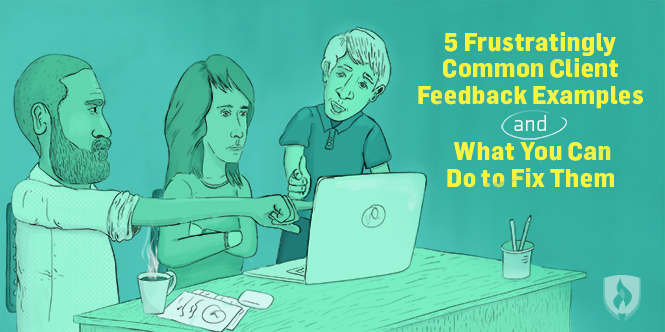5 Frustratingly Common Client Feedback Examples and How to Overcome Them
By Will Erstad on 08/23/2016

It has become a rite of passage for new design professionals to receive (and subsequently struggle with the horrors of) client feedback.
Design is subjective—anyone can look at an image and decide if they like it or hate it based on a gut feeling. The challenge for designers is to work with clients who might not have the time or vocabulary to express what exactly they like or don’t like about a project.
In this article we’ll cover some of the most common, unhelpful pieces of client feedback you’ll inevitably encounter throughout your design career. And even more helpful, we’ll give you some tips on how to maximize the revision process.
5 annoyingly ambiguous client feedback examples
1. “I like purple. Make it more purple! Oh, and can we add some mountains?”
“Most clients are personally invested and very attached when it comes to their business,” says Sherry Holub, creative director at JV Media Design. “They may have trouble separating their personal likes from what will work for their audience.”
This type of feedback isn’t always frustrating—if you’ve found someone who wants to pay you to make a “pretty” reflection of things they enjoy, good for you! Go hog wild and make the purple-est mountains possible.
But odds are, the client is asking you to create a design that actually serves a business purpose. Those purple mountains don’t make a whole lot of sense in the logo of, say, Joe Schmoe’s Auto Body Shop. Following the whims of a client doesn’t just hurt your overall design, it hurts the business for which you’re working (not to mention your own reputation!)
How to fix it: There’s always going to be an element of design that hinges on a client’s personal preference, and that’s fine. The key is to rein it in. Before you begin your design work, help your client create a rough creative brief that will serve as a guideline for evaluating feedback later on. This will serve as the guidelines upon which you both agreed from the start, so it’ll be easier to veto outlandish suggestions down the line.
2. “Can we make this more [insert vague adjective here]?”
Whatever that adjective may be (fun, modern, cool, exciting, etc.) it’s not very descriptive or helpful. Phrases like “jazz it up” or “make it pop” have very little meaning in the opinion of a graphic designer. In fact, you probably cringe at the sound of them.
How to fix it: “Many designers … don’t know how to get better feedback and in turn just blame the client,” Holub says. “It’s really the designer’s job to be able to guide a client and extract proper feedback.”
Like with a lot of frustrating client feedback, this issue boils down to communication. If you receive unclear feedback, it’s up to you to push back with clarifying questions. If they want the design more “modern”, try to find existing examples you think fit the bill and ask if you’re on the right track. Dig into the specifics to find what exactly needs changing. This could save you from throwing out an entire design when a relatively minor tweak will do.
3. “Just keep designing. Once I see it, I’ll know if it works.”
“Some of the worst cases are being given no direction and the client expecting you to read their minds,” says freelance graphic designer Angelika Bergerioux.
Similar to complete silence, this feedback can easily result in hours of unnecessary work. While it is understandably easier to pick a favorite design from a bunch of existing options, there’s a better, more efficient way to do things.
How to fix it: Not to repeat ourselves, but behold the power of a written contract with terms stating the number of revisions included for a set price. That should at least bring the client to the table with some meaningful input.
Even with the help of a contract you’ll still need to offer some guidance. Shana Haynie, creative director at Splash OPM, says asking what emotions the project should evoke while providing examples of distinct style options can help you narrow it down. Don’t be afraid to just keep asking questions until you feel comfortable.
“Maybe your client doesn’t know how to articulate what they want,” Haynie says. “It’s your job to get it out of them using whatever means necessary.”
4. “I like it, but Steve, Linda and Gary all have a few tweaks they’d like to make.”
Welcome to design death by committee. Everyone and their cousin has an opinion on your design, yet no one seems to have final say. You can try to pull pieces of their feedback to create a Frankenstein-like revision, but this will likely leave everyone a little unhappy and could result in an endless wave of revisions if your process isn’t tightly defined.
How to fix it: “Tell your clients directly that the fewer people with opinions, the better the design will turn out,” says Jean Paldan, managing director of Rare Form New Media. The key is not to stifle feedback, as that leads to different problems, but to work with clients to ensure they have a “decider” of the group who has final say. That puts the responsibility of gathering feedback and boiling it down to what is most important on the client’s shoulders, instead of forcing you to sift through and deal with the client’s internal power struggles.
5. Complete silence
Don’t let the quiet fool you into thinking you’ve hit a homerun with your first attempt. After hearing the other examples, it may seem like no feedback is good feedback, but lack of input can make for much larger problems.
“The single most maddeningly frustrating feedback you can get from a client is their silence,” says freelance designer Brandy Miller. “I always worry if they don’t have some criticism to offer.”
Miller says a lack of feedback often signals that a client is either not interested in what’s being created, or doesn’t want to hurt your feelings with critical comments. While it may be nice to avoid the sting of a critique in the short-term, it’s much better to get honest feedback and use that to create something the client is genuinely happy with. This is particularly true for clients with whom you’d like to build an ongoing relationship.
How to fix it: There are a few sound strategies for tackling this. Miller recommends simply being direct in letting the client know that this is a collaboration and you expect to receive honest, constructive feedback to create the best final product. If they’re still clammed up, appeal to their wallets. Make a written contract stating they have 2 or 3 rounds of revisions before you’ll need to charge extra. This will highlight the importance of offering productive feedback.
Go forth and ‘make it pop’
Frustrating client feedback is a fact of life as a creative professional. Not every client is going to be equipped with the knowledge necessary to offer helpful feedback when gathering their initial thoughts. It’s up to you to master the communication skills necessary for interpreting a client’s gut feeling about a design.
Don’t get discouraged if your first attempt at guiding a client through the revision process doesn’t go perfectly; it’s a learning process. You can be a wizard with the entire Adobe Creative Suite and still have room for improvement as a freelance graphic designer.
RELATED ARTICLES:




